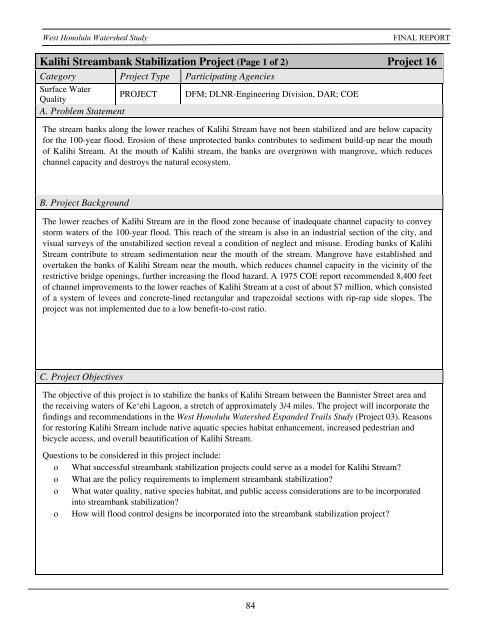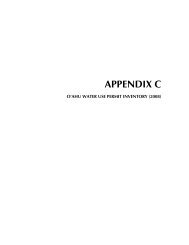West Honolulu Watershed Study - Final Report - Prepared for
West Honolulu Watershed Study - Final Report - Prepared for
West Honolulu Watershed Study - Final Report - Prepared for
You also want an ePaper? Increase the reach of your titles
YUMPU automatically turns print PDFs into web optimized ePapers that Google loves.
<strong>West</strong> <strong>Honolulu</strong> <strong>Watershed</strong> <strong>Study</strong> FINAL REPORT<br />
Kalihi Streambank Stabilization Project (Page 1 of 2) Project 16<br />
Category Project Type Participating Agencies<br />
Surface Water<br />
Quality<br />
PROJECT DFM; DLNR-Engineering Division, DAR; COE<br />
A. Problem Statement<br />
The stream banks along the lower reaches of Kalihi Stream have not been stabilized and are below capacity<br />
<strong>for</strong> the 100-year flood. Erosion of these unprotected banks contributes to sediment build-up near the mouth<br />
of Kalihi Stream. At the mouth of Kalihi stream, the banks are overgrown with mangrove, which reduces<br />
channel capacity and destroys the natural ecosystem.<br />
B. Project Background<br />
The lower reaches of Kalihi Stream are in the flood zone because of inadequate channel capacity to convey<br />
storm waters of the 100-year flood. This reach of the stream is also in an industrial section of the city, and<br />
visual surveys of the unstabilized section reveal a condition of neglect and misuse. Eroding banks of Kalihi<br />
Stream contribute to stream sedimentation near the mouth of the stream. Mangrove have established and<br />
overtaken the banks of Kalihi Stream near the mouth, which reduces channel capacity in the vicinity of the<br />
restrictive bridge openings, further increasing the flood hazard. A 1975 COE report recommended 8,400 feet<br />
of channel improvements to the lower reaches of Kalihi Stream at a cost of about $7 million, which consisted<br />
of a system of levees and concrete-lined rectangular and trapezoidal sections with rip-rap side slopes. The<br />
project was not implemented due to a low benefit-to-cost ratio.<br />
C. Project Objectives<br />
The objective of this project is to stabilize the banks of Kalihi Stream between the Bannister Street area and<br />
the receiving waters of Ke‘ehi Lagoon, a stretch of approximately 3/4 miles. The project will incorporate the<br />
findings and recommendations in the <strong>West</strong> <strong>Honolulu</strong> <strong>Watershed</strong> Expanded Trails <strong>Study</strong> (Project 03). Reasons<br />
<strong>for</strong> restoring Kalihi Stream include native aquatic species habitat enhancement, increased pedestrian and<br />
bicycle access, and overall beautification of Kalihi Stream.<br />
Questions to be considered in this project include:<br />
ο What successful streambank stabilization projects could serve as a model <strong>for</strong> Kalihi Stream?<br />
ο What are the policy requirements to implement streambank stabilization?<br />
ο What water quality, native species habitat, and public access considerations are to be incorporated<br />
into streambank stabilization?<br />
ο How will flood control designs be incorporated into the streambank stabilization project?<br />
84



